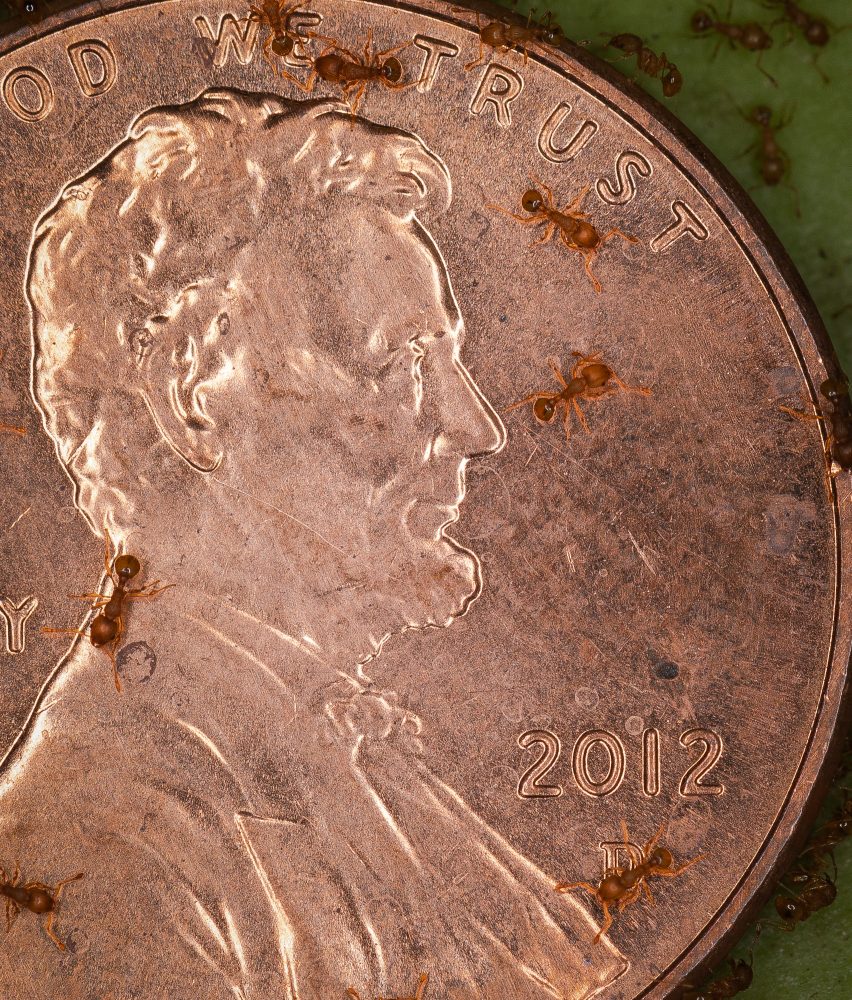An infestation of little fire ants (LFA) has been detected at an area known as Twin Falls, in Huelo, East Maui. The infestation was reported in early November, by both an area resident living within the infested zone and a former employee of the Maui Invasive Species Committee (MISC) who had been stung while visiting the popular hiking and swimming site off the Hana Highway.

Do not remove anything from a known infestation to avoid spreading little fire ants. MISC file photo 
Little fire ants easily fall off overhanging vegetation. Stings on the neck and torso can indicate the presence of this invasive ant. MISC file photo. 
Little fire ants, Wasmannia auropunctata, on a penny. Photo by Zach Pezzillo. 
A little fire ant, Wasmannia auropunctata, on the tip of an index finger. Photo by Zach Pezzillo.
On Hawaii Island, residents and visitors have abandoned popular trails and waterfall hikes because of the rain of stinging ants that fall on them as they pass through overhanging vegetation.
On November 14th, two dozen people – both local residents and community members from elsewhere on Maui, worked with MISC and Hawaii Department of Agriculture personnel to place and collect samples to determine the size and spread of the infestation.
At approximately eight acres, the infestation encompasses several homes and some areas frequented by hikers and swimmers. Samples collected downstream from the core of the infestation have little fire ants – additional survey work will determine if the ants have spread along the waterway.
This find marks the third detection of the year on Maui, consistent with the trend of detecting two to three little fire ant populations each year. “We are fortunate to have strong community awareness – public reporting of little fire ants continues to be the most effective way to find populations,” says Adam Radford, MISC manager. MISC is actively treating ten populations of little fire ants.
Thanks to funding from Maui County and the Hawaii Invasive Species Council the LFA response team is expanding by two to address this growing problem. MISC continues to partner with Maui HDOA staff in following up on reports and treatment efforts from Kapalua to Hana. The most important part of successful containment is community participation.
“If we are to keep little fire ants from becoming established, we need to find the populations early while they are still small – – we need the community to remain vigilant, actively checking for little fire ants whenever new material (potted plants, mulch, or anything stored outside) is introduced to their homes and reporting suspected populations of little fire ants early on. We know new populations will continue to be discovered, and we’re prepared for that, we’ve been highly successful at removal throughout Maui,” says Radford.
There will be a community meeting on Thursday, December 5th, at 6:00 pm at the Haiku Community Center to discuss what is known about the Twin Falls little fire ant infestation and plans for eradication.
Visit stoptheant.org to find out more information on collecting samples of ants and the status of LFA on Maui and throughout the state. Suspected populations of little fire ants can be reported to the Maui Branch of the Hawaii Department of Agriculture at 808-873-3080, or the Maui Invasive Species Committee at 808-573-6472.
PDF link: Press-Release-Little-Fire-Ants-Twin-Falls_112719.pdf
